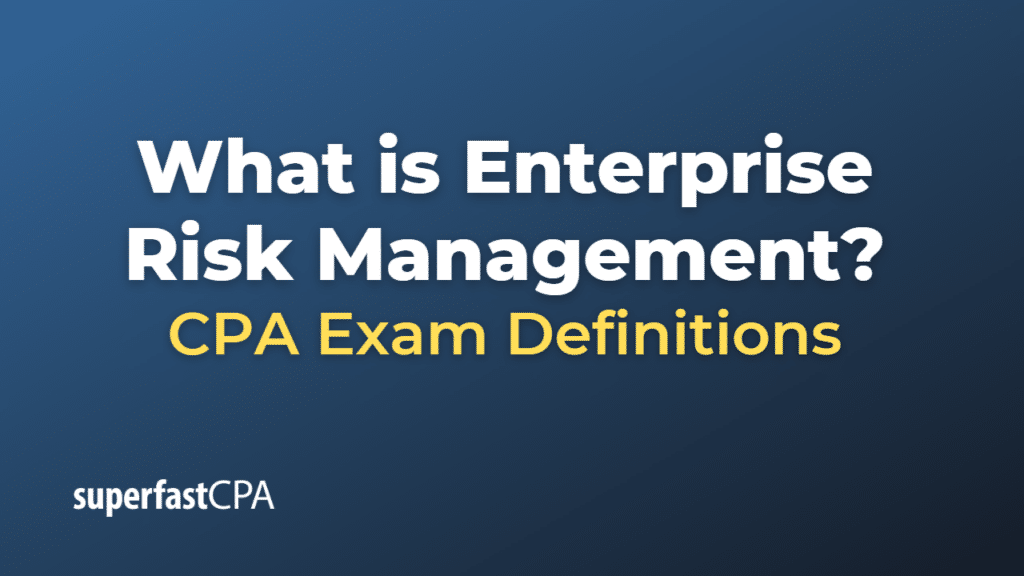Enterprise Risk Management
Enterprise Risk Management (ERM) is a comprehensive approach to identifying, assessing, and responding to potential risks that might affect an organization’s operations and objectives. It involves planning, organizing, leading, and controlling the organization’s activities to minimize the effects of risk on an organization’s capital and earnings.
ERM expands the process to include not just risks associated with accidental losses, but also financial, strategic, operational, and other risks.
Key steps in an ERM process often include:
- Identify Risks: Recognizing the potential risks that could impact the organization. These risks could be internal (like operational inefficiencies) or external (like changes in market conditions).
- Assess Risks: Evaluating the potential impact of identified risks and their probability of occurrence.
- Develop Strategy: Developing strategies to manage identified risks. Strategies could include avoiding the risk, reducing the negative effect or probability of the risk, transferring the risk to another party, or accepting some or all of the potential or actual consequences of a particular risk.
- Implement Strategy: Implementing the risk management strategies decided upon.
- Monitor and Review: Regularly monitoring and reviewing the performance of the risk management strategies and making adjustments as necessary.
ERM provides a framework for risk management, which typically involves identifying particular events or circumstances relevant to the organization’s objectives (risks and opportunities), assessing them in terms of likelihood and magnitude of impact, determining a response strategy, and monitoring progress.
The goal of ERM is not to eliminate all risk, but to manage it in a way that aligns with the organization’s risk appetite and business objectives. It should also provide reasonable assurance to an entity’s management and board of directors.
By identifying and proactively addressing risks and opportunities, business enterprises protect and create value for their stakeholders, including owners, employees, customers, regulators, and society overall.
Example of Enterprise Risk Management
Let’s consider an example of a multinational corporation implementing Enterprise Risk Management (ERM).
ABC Corp. is a multinational company that operates in several countries across various sectors including manufacturing, retail, and real estate. Due to the vastness of its operations, it faces a range of risks – operational, financial, strategic, and more. To effectively manage these risks, ABC Corp. decides to implement an ERM framework.
- Identify Risks: ABC Corp’s ERM team starts by identifying potential risks across all their operations. For instance, they identify risks such as fluctuating exchange rates affecting the costs of imported raw materials, changes in local regulations impacting their real estate projects, or a major system failure disrupting their manufacturing process.
- Assess Risks: Next, the ERM team assesses each risk to understand its potential impact and the likelihood of its occurrence. For example, they might determine that a major system failure in the manufacturing unit could result in a high financial loss and that the likelihood is moderate.
- Develop Strategy: Based on the risk assessment, the ERM team devises strategies to manage the risks. To mitigate the risk of a system failure, they might decide to upgrade their system infrastructure and implement a robust system maintenance and monitoring protocol.
- Implement Strategy: The ERM team works with the relevant departments to implement the risk management strategies. They coordinate with the IT department to upgrade the system infrastructure and establish the new protocols.
- Monitor and Review: Finally, the ERM team establishes a process for continuously monitoring the identified risks and the effectiveness of the measures in place. They set up regular reviews of the system infrastructure to ensure it’s properly maintained and monitored.
Through this ERM process, ABC Corp. manages its risks in a comprehensive and proactive way, aligning with its overall business strategy and objectives. It helps the company to avoid potential losses, seize opportunities, and ultimately achieve its business goals.













